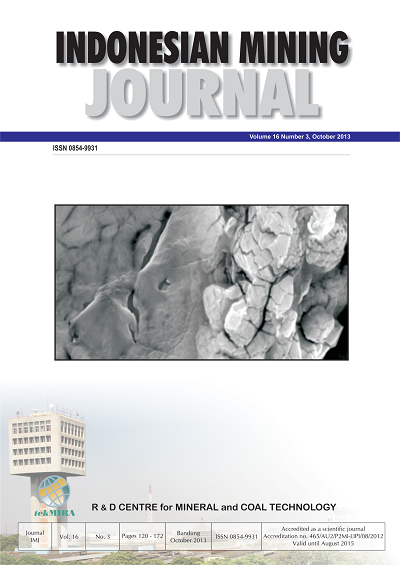EFFECT OF REAGENT VOLUME AND CONCENTRATION ON RECOVERIES OF MgO AND SO3 WITHIN SYNTHETIC DOLOMITE-BASED KIESERITE
DOI:
https://doi.org/10.30556/imj.Vol16.No3.2013.384Keywords:
kieserite, dolomite, sulfuric acid, MgO, MgSO4, CaSO4Abstract
Natural kieserite is usually used for the production of epsom salt and fertilizer. Normally, the mineral is mined from geologic marine deposits and provides a soluble source of both Mg and S for plant nutrition. However, natural kieserite cannot be found in Indonesia. The fact that this country retains a lot of dolomite deposits and such a material can be processed into synthetic kieserite by sulphatization process seems promising for fertilizer industry in Indonesia. Varying the sulfuric acid concentration between 2 and 5 N and its volume from
29.50 to 94.80 ml produces the MgO in MgSO4 filtrate below the specification as stated in Indonesian National Standard (14 – 19%) though its sulfur content has satisfied the requirements. It is assumed that some MgO’s (around 1.93 – 7.12%) are still available in CaSO4 deposit. To get the optimum results, an appropriate calcula- tion is required when adding sulfuric acid to the process and the solution should be in neutral condition prior to separating MgSO4 – CaSO4 as well.
References
Atangsaputra, K. 2000. Pembuatan Kiserit dari Ser- pentin, Sukabumi Selatan. LaporanTeknik Pen- golahan, No. 197. Puslitbang Teknologi Mineral, Bandung.
Agung, B. dan Wahyudi, T., 2008. Karakteristik dan Pemanfaatan Terak Feronikel untuk Pupuk Kiserit. Jurnal Bahan Galian Industri, v. 12 n. 33 h. 22-32. Puslitbang Teknologi Mineral dan Batubara, Bandung.
Badan Penelitian dan Pengembangan Propinsi Su- matera Utara. 2009. Kajian Deposit Bahan Baku untuk Pengembangan Pupuk Kiserit di Sumatera Utara. Laporan Akhir. Balitbangda Sumatera Utara, Medan.
Ma, Hongwei, Bish, D.L., Wang, Hsiu Wen, Cipera, S.J., 2009. Determination of the crystal structure of sanderite, MgSO4•2H2O, by X-ray powder dif- fraction and the charge flipping method. American Mineralogist, v. 94, p. 622–625.
http://pustan.bpkimi.kemenperin.go.id/fi02-2807-1992.PD accessed on 13 March 2014 at 2 pm.
http://www.geology.wmich.edu/koretsky/ mineralogy/14xrd.pdf accessed on 17 March 2014 at 1 pm.
http://www.dolomite.co.nz/page/2/ accessed on 17 March 2014 at 10 am.
Kaczmarek, S.E. and Sibley, D.F. 2011. On the evolu- tion of dolomite stoichiometry and cation order during high-temperature synthesis experiments: An alternative model for the geochemical evolution of natural dolomites”. Sedimentary Geology, v. 240 n. 1. Elsevier.
Singh, R. K. 2013. Evaluation of Process conditions for Magnesium Production from Dolomite Ore Using CALPHAD Method. Summer Project Report. CSIR – National Metallurgical Laboratory. Bhopal.
Wahyudi,T dan Agung. B. 2010. Uji Coba Pelarutan Dolomit Karo dengan Asam Sulfat Menjadi Kiserit. Jurnal tekMIRA, v. 6, no. 04, Oktober 2010.
Downloads
Issue
Section
License
Indonesian Mining Journal provides immediate open access to its content on the principle that making research freely available to the public to supports a greater global exchange of knowledge.

This work is licensed under a Creative Commons Attribution-NonCommercial 4.0 International License.













